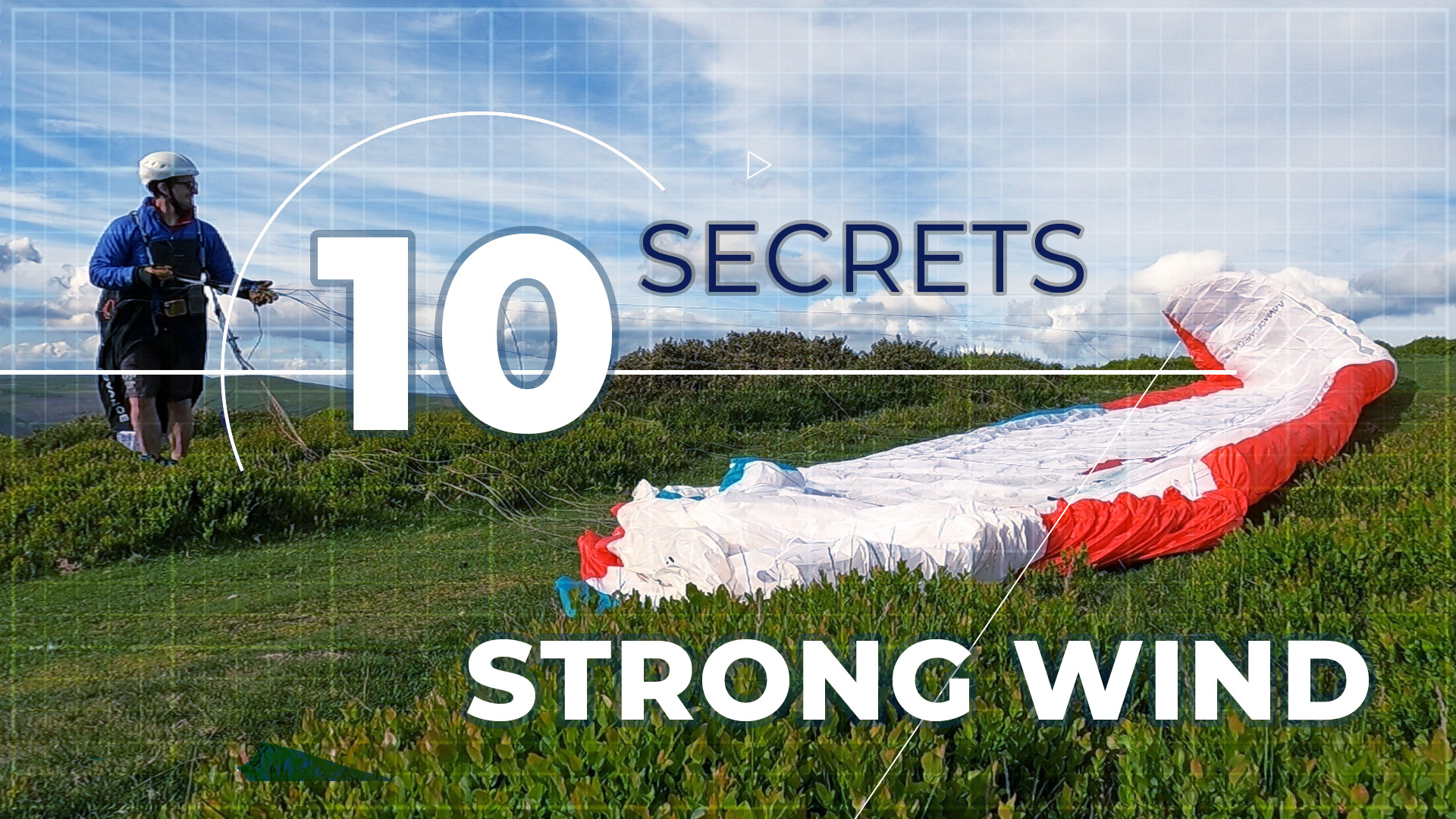What are the secrets of paragliding in strong wind? How do you do this safely? In this article we’ll go through the ten things you can do on your paraglider, when it’s windy!
What is strong wind? Anything over 20 mph (or 32 km/h), where you will probably begin to drift backwards on your paraglider at times. This can mess up your day.
What’s the danger? Well firstly you don’t land where you expect to, and some places are just … ugly! But the main risk is the turbulence that strong wind creates. The air will get WILD, especially behind obstacles. This makes wing control challenging. Finally, most pilots don’t have an effective kill method so get dragged by the wing when landing in strong wind, which can be lethal.
1. Strong wind forecasting for paraglider pilots
Check the right forecasts! The normal weather predictions are for the surface level, which is usually much less than the wind will be 100m above ground! So use a service like windy.com and refer to the forecast altitude at which you’ll be flying. Even better is a smart forecast like RASP that can model the soaring airflows in the whole flying layer.
2. Strong wind over terrain
Most forecasts don’t understand the ‘venturi effect’. This is how your wing works, the air accelerates over the curved upper surface, and out in front, there is a magic separation point. Map this idea onto the landscape and you’ll find the places where the wind splits and the strength will be reduced. That’s where you want to launch. Avoid places where the valley narrows or the terrain falls, and especially where sharp spines will make rotor.
3. Strong wind paraglider layout
Wings laid all the way open are hazards to everyone. Rig your gear parallel with the wind. You can get it mostly open, then bunch it up to move to launch.
4. Strong wind paraglider launch
Position yourself at the front of the launch pad to create safe depower space. Launch from a rosette and move downwind to reduce power. If you need to kill the launch, run downwind first before your control input. If you’re more experienced, you have the option of launching to one side, and only opening enough to see you’re not twisted. There’s a whole video course about these methods, available on my website.
5. Strong wind turbulence
Any sharp edged obstacle creates a turbulent wash downwind of itself, which is carried further than you might think. There’s a ‘rule of thumb’ from Denis Pagen of Height of obstacle x wind strength in mph. So in 10mph it’s would be 10:1 and in 20mph it would be 20:1. Turbulence increases at the square of the increase in velocity. So expect a ‘ground wash layer’ if you’re landing backwards.
6. Strong wind soaring on paragliders
If your ground speed is down to single digits, keep yourself over steep terrain where you can move forward. Shallow terrain causes more horizontal airflow that can push you back more. Don’t fight the wind head on, aim at right angles to the ridge lines to escape from terrain traps. It might be safest to bench up and run rather than fighting into the wind with a terrible glide. Large regions of compact mountains are dangerous in strong wind because they offer very few escape routes. You will find leeside rotor, heavy sink and unpredictable redirection of wind flows. Use full speedbar. Big ears will be slower.
7. Strong wind thermaling on paragliders
If there is wind near the surface, the thermal will carry that turbulence upwards. If it has risen into wind aloft, it will have a hard edge on the upwind side. So in strong wind you have to be strong on the controls, to keep the wing in the lift, escape from the sink, and catch sudden surges and loss of leading edge tension. Because the thermals are tilted over, you also need to push into wind more on each circle to avoid dropping out the back.
If you thermal over rising terrain in really strong wind, you are not coming back … unless your vario reading is stronger than 10m/s. This isn’t a realistic climb, so forget it. You’re going downwind. BUT … if you park over rising terrain and dolphin into wind, slowing down in lift, you can ride each passing climb and gain altitude step by step until you have enough height to get a safe downwind glidepath that isn’t so terribly committing.
8. Strong wind landing approach
Because of the distance turbulence travels, find channels lined up with the wind so the turbulence has space to dissipate. Approach from the upwind edge and back in.
9. Strong wind paraglider kill method
Do your final approach using only your rear risers, and do a late, aggressive flare using only the rear risers. Turn and run as soon as your feet touch down and keep the rear risers pulled in. On most wings, this will do the trick. For a more effective method that works even if you’ve got linked risers or restrictive rigging, use the A kill as demonstrated in KILLING IT. This A-kill method needs practice!
10. Strong wind paragliding … and your limits!
All said and done, paragliding in strong wind can be dangerous. Small pilots will be swept away well before large pilots, and beginners get it the worst because of their ‘safe’ but thick aerofoils and limited accelerators. So … practice your launch and landing methods. Check your forecasts, and scratch out any days with 20mph anywhere near the terrain. (For the faster metric pilots that’s 32km/h). Be the smart pilot out in front, always moving to the separation point on the landscape. And stay well away from the rough air downwind of sharp edges.
I hope that using these tips you can avoid strong wind situations.
There’s a detailed lesson on strong wind control in my free trial!
Get a taste for paragliding and training online with me. In this free short course you’ll get a daily email with new lessons to enjoy. You’ll learn real skills you can apply to your paragliding, and see how the Flight Academy works.

